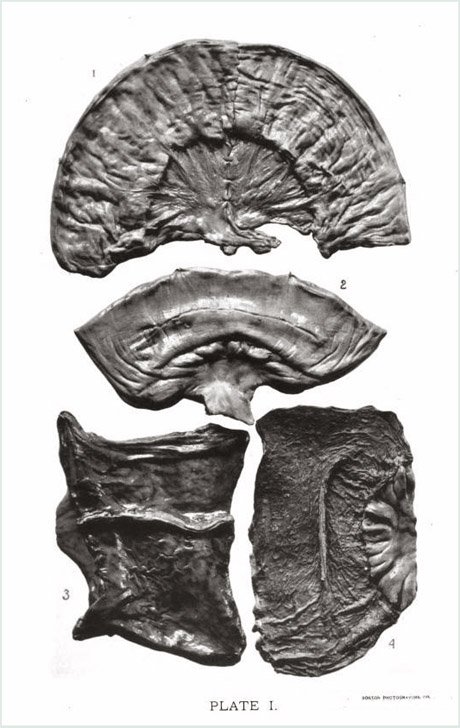
Journal : Medical and surgical reports of the City Hospital, Boston ; series 4.
Boston : Rockwell & Churchill, 1889.
Description : 83-101, [1 l.] pl. ; ill.: 1 photo. pl., 16 figs. ; 24 cm.
Photograph : 1 photogravure leaf with 4 images.
Subject : Intestines — Sutures ; Anastomosis.
Notes :
Human Ileum. Natural size. The specimens from which this plate was
prepared were subjected to considerable manipulation before and while being photographed. This explains the exposure
of the suture at two points in Fig. 2.
Figure 1. Resection wound closed with "Right Angle" suture. Wound
of mesentery united with "inverted Lembert" (interrupted). The resection suture is terminated at a point one-fourth
of an inch above the mesenteric border of the intestine.
Fig. 2. Longitudinal wound, closed by same suture.
Fig. 3 shows Fig. 1 from inside. Intestine has been cut open at about
one-fourth its circumference from its mesenteric attachment, thus showing the manner in which the resected wound
edges are inverted and apposed ; also the accuracy of apposition at the site of the mesenteric insertion. The
exposure of the suture at two points on the upper side of the wound is an apparent one only. The suture was not
visible in the specimen from which the plate was taken.
Fig. 4 shows Fig. 2 from inside. Intestine is cut open along the
mesenteric border and turned back, thus exposing the mucous surface. Shows the amount of inversion of the wound
edges, and the manner in which the edges are apposed.

Hayward Warren Cushing's name was often confused with that of the neurosurgeon Harvey Williams Cushing (1869-1939), also of Harvard—a brilliant young talent whom Hayward considered an "upstart." The WorldCat catalog (as of this writing, 12-02-08) wrongly attributes this paper to Harvey Cushing and even the Surgeon General Catalog gets his first name wrong, misspelling it "Hayworth."
